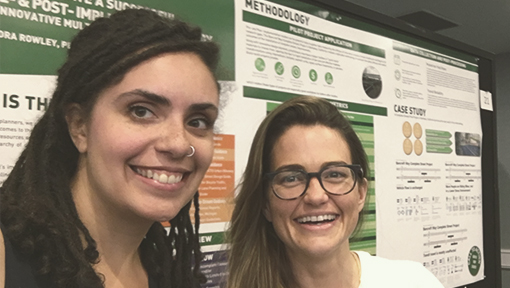Lessons Shared & Learned at APBP 2019
The Association of Pedestrian and Bicycle Professionals (APBP) conference in Portland, OR covered a range of topics, including the interaction between autonomous vehicles (AVs) and pedestrians, planning for safe and inclusive communities, and how agencies can prepare for and regulate micromobility.
While speakers shared successes from across the country, many also acknowledged the work still unfinished. Increasingly more communities are committing to Vision Zero, yet bicycle and pedestrian fatalities have yet to decline. Equity has joined our planning lexicon, yet disparate infrastructure and impacts are a reality for most underserved communities. Though we’re not yet meeting all our goals, agency staff and consultants alike charged themselves and other participants with doing better and doing more. The humble tone was refreshing, and speakers’ calls to action were inspiring.
Insights on Conference Topics
Micromobility
Micromobility modes are here, and they’re growing and expanding in communities both large and small. Agencies are eager to learn from others, specifically when it comes to regulation and management of micromobility vendors.
Autonomous Vehicles
AVs are far off, but we can start planning for them now. Pedestrian and bicycle improvements that will improve AV detection are also those improving the safety of these modes today.
Bikeway Design
Bikeway design guidance will be improving in the coming months with the next version of the AASHTO Bikeway Design Guide, along with forthcoming research on user comfort from Portland State University.
Equity
Promoting equity requires a holistic approach, looking both internally at our hiring and mentoring practices and externally at how we engage with diverse communities and develop solutions to meet their needs. Transportation practitioners have to be knowledgeable and comfortable with the complexities of the issues outside of our field; including but not limited to displacement, homelessness, and personal safety.
Systemic Safety
Systemic safety approaches are gaining traction as new cities make commitments to tackling roadway safety in an equitable, holistic, and data-driven manner. With a new understanding of risk factors and the countermeasures that can be effective in mitigating those risks citywide, local agencies are now undertaking the challenges of how to fund, design, implement, and evaluate the effectiveness of systemic safety projects.
Curbside Management
Curbside management is an issue faced by several agencies, though agency specific needs vary. Some agencies are seeking assistance in how they can monetize the curb. If metered on-street parking is replaced with passenger or commercial zones, agencies are seeking ways to replace the lost revenue.
Complete Streets
Project evaluation for innovative complete streets treatments requires understanding not only what data is important, but also how to collect the data effectively and efficiently.

Fehr & Peers poster session at APBP 2019.
Learn more by contacting one of our industry experts.
Quick Links
© 2017 – 2024 Fehr & Peers. All rights reserved.

